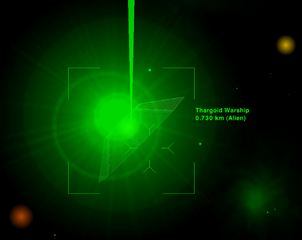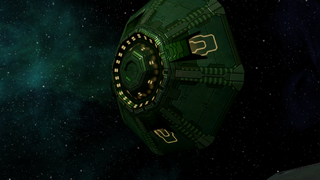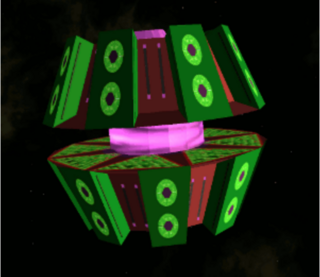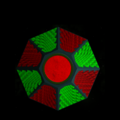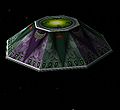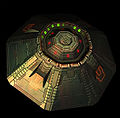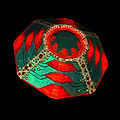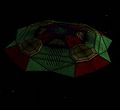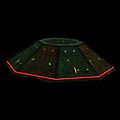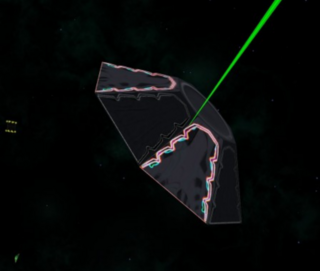Thargoids
- This page is about the Thargoids as a race and culture. For other uses, see Thargoid (disambiguation)
- NOTE: This information is NOT CANON for the Elite: Dangerous setting. Some points within this article are speculation.
Thargoids, or the Thargoid race, is a belligerent, warlike insectoid race who originate from somewhere outside known space. It is thought that they may be an extra-galactic species.
Contents
Overview
| Thargoids are a race of sentient insects whose relations with all members of the Galactic Commonwealth, without exception, are limited to a short definition: permanent war. I doubt anyone knows exactly where they came from. It is only known that the Thargoid warships make raids from interstellar space and return there. You can hear a lot of nonsense about the Thargoids. They say that the Thargoids hatch plans for total domination over all the inhabited worlds of the Commonwealth. There is gossip about unscrupulous politicians secretly bargaining with the Thargoids for their share in the future world order. This is all complete nonsense. Even the most notorious villain will not deal with Thargoids for the simple reason that the Thargoids do not consider it necessary to negotiate with anyone. Power over the cosmos in our understanding does not interest them. They appear without asking, take by force what they need – usually agricultural products and minerals – and leave without saying goodbye.
It is also rumored that the Thargoids have no fear or pity in combat, and that most of their pilots fight at the Elite-class level. People who have had to meet with the Thargoids in battle – and there are few of them even in the Navy – believe that this is only partly so. A single Thargoid warship is not particularly dangerous. The problem is that Thargoids usually attack in a flock, and each mother ship carries up to five Thargons – small unmanned fighters. Shooting these nimble ships separately is a waste of time, the only chance to win the battle with the Thargoids is to destroy all the mother ships, since the surviving Thargoids take control of the Thargons. It sounds simple, but in truth, few people can confirm the effectiveness of this recipe with their experience... Knowledgeable people say that in the old war with the Thargoids, that the invasions began with the appearance of a single lone Thargoid. A single scout appearing, sniffing out the situation, and then leaving. And then a large flock invading the system. |
| (Stranger's Hermit) |
History
Syncretist
The Syncretists have crafted a history which unites Oolite with Elite, Frontier & FFE
2849 - first encounter between GalCop and Thargoid vessels. They are found to be belligerent and ruthless in stellar combat.
2851 - first recorded Thargoid invasion of a GalCop system. The Galactic Navy is mobilised and its structure is reorganised.
2870-2875 - Thargoid warfare settles into a series of warzones. Regular sorties are made by lone vessels into some surrounding systems.
Purist
The purists have crafted a history to explain the peculiarities of the Ooniverse
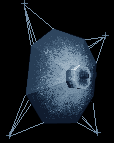
years ago year Event 295 5414 End of Golden Age, first Thargoids confirmed 82 5627 Thargoid invasion 71 5638 GalCop allows weapons on civilian ships 60 5649 Elite Federation of Pilots formed 46 5663 EFP recognised by GalCop 13 5696 Thargoid 2nd Invasion 10 5699 Commander Jameson becomes first Elite pilot 5 5704 Battle of Inera (Jameson dies) 3 5706 Battle of Isxees, defeat of Thargoids, GalCop hamstrung 0 5709 today
Philosophy of history
For more on the distinction (if you can stand it!) see Lore.
Appearance
The common Thargoid warrior is a dark chitin-covered insect measuring just over 7 feet / 2 metres in height. They have six limbs, two of which are dedicated walking limbs (legs). The remaining four limbs have jointed hands each possessing three digits, one of which is an opposable thumb.
The head is a triangular ovoid in shape, with prominent faceted eyes mounted to the front. In general, the overall impression is similar to that of a praying mantis. There are two short antennae that protrude from the top of the head. The mouth is on the underside of the front point of the triangular head, and is relatively small. It is surrounded to two strong mandibles. The neck is very short but thick and sturdy, and can rotate 60 degrees.
The body of a Thargoid is segmented into two distinct sections. The upper segment is approximately egg-shaped with a slight distension at the upper end just below the junction to the neck and head; this is where the upper limbs join the body. The lower segment is a tapered oval that arcs slightly towards the rear and forms a rounded point. The junction of these two segments is a heavily muscled narrow waist which the Thargoid can twist to approximately 100 degrees.
The lower four limbs are attached to the lower body segment. The lowest pair, or the traditional legs, are attached just above the point where the segment begins to bend rearwards. These legs have knee joints and ankle joint, and are terminated with clawed appendages. The ankles allow the Thargoid to use the lowest part of the limb as feet, providing stability and agility when standing erect. These legs are also double jointed at the knees. The middle pair of limbs are primarily used as manipulating limbs, but are also seen as propelling limbs when a Thargoid is running. These limbs are jointed at elbow and wrist, and end in clawed hands. There are four digits, including an opposable thumb, and these are clawed. The claws are short and horny. These legs are usually held folded against the front of the body.
The upper limbs are dedicated manipulatory limbs. These are jointed at the elbows and wrists. The elbow is jointed to the rear, similar to human arms. The hands end in four clawed digits, one of which is an opposable thumb. These digits are more flexible and agile than the ones on the middle limbs.
Thargoids can walk erect on the hind legs, but have been seen to drop to four legs when running, using the middle limbs in addition to the rear legs.
Not much is known about the internal workings of Thargoid anatomy. Dissection of specimens have revealed the presence of several organs analogous to humans, as well as some that are common in insectoid races. Oresrian medical personnel have verified the presence of respiratory and circulatory organs as well as the digestive organs and system. They have also identified several glands such as excretory, pheromonal and communication glands (most insectoid communication is a hybrid of aural and pheromone methods). The fabled 'fear glands' thought to be removed from Thargoid warriors are thought to be located in the upper thorax, where scar tissue has been found. No notable reproductive organs have been found in specimens, leading scientists to theorise that there must be a separate phenotype of Thargoid that is responsible for the reproductive act.
Society
Not much information has been obtained about Thargoid society or culture. The only known fact is that the society is hive based, with no sense of close family. It is thought that the society is divided into colonies, possibly along the lines of ant colonies.
Thargoids are thought to have a natural affinity with space, and with witchspace in particular. This is due to the fact that Thargoid warriors seem to spend a large amount of time in space. Naval pilots and crews report that the warships in the war zones are encountered on repeated occasions over a period of months often without respite.
Based on the study of some wrecked ships, Thargoids as a race seem to have a very spartan approach to furnishing and belongings. Crew quarters are practically devoid of possessions other than those necessary for military crew. All belongings are functional and necessary.
Politics
NOTE: This politics section is written from the Syncretist perspective (see Lore).
Nothing is known about internal Thargoid politics.
Thargoid relations with other races is frighteningly simple: war. The three largest organisations in Galaxy 1 are all at war with the Thargoid race, and they are constantly under threat of planetary invasion.
The Thargoid invasions usually seem to be prompted by the need for either agricultural or mineral resources, rather than a sociological or anthropological need to expand or colonise. In fact, the animal life on an invaded world is largely ignored unless it poses a threat to Thargoids.
Technology
Thargoid technology is vastly different and in many ways far superior to established GalCop technology. The warships have no visible form of propulsion, neither from vented emissions nor engine exhausts, yet they are manoeuvrable and agile.
The Thargoids are also superior in the use of advanced AI and remote craft, an area in which GalCop is sadly behind.
Other fields of technology that the Thargoids are in advance of GalCop, include metallurgy, biogenetics, physics and weapons tech. Their hyperdrives and shield technologies are also superior.
Thargoid tactics
In recent years the Thargoids have changed tactics slightly - they can appear on any spacelane (when entering a system, they use their superior witchspace technology to appear well clear of the potentially patrolled witchpoint) and in other places too - and are much more likely to appear in "bottleneck" systems, especially those poorly defended by the local forces, than other systems. (Source)
Links
- Thargoid (disambiguation)
- Dealing with Thargoids Tips on how to!
- Thargoid Warship (Oolite)
- Thargoid Robot Fighter (Oolite) (Thargon!)
- Oresrians Easily confused with Thargoids!
Discussions
- Possible Thargoid Backstory (2012)
- Weird nugget of info about the Thargoids...
- Are Thargoids really all that threatening? Wide ranging discussion (2012-13) - mostly from a syncretist perspective.
OXPs
Thargoid Retextures
Note: different authors have different conceptions of the Thargoids. These will not all be conceptually compatible...
More Thargoid variety
- Extra Thargoids by Uk Eliter (2011-20)
- Lazarus OXP Thargons coming back from the dead! By Thargoid (2013)
- Swarm OXP New variants by Thargoid (2014)
- Thargoid Carrier New variant by ADCK (2012?)
- Thargoid Witchspace Drive Equipment by Capt. Murphy (2012)
- Thargoid Warship (Flyable) New variant by Pleb87 (2013)
- Thargorn Threat oxp New variants by Eric Walch (2013)
- Second Wave OXP New variants by Thargoid (2011)
- Thargoid Weaponry by Nexus-Hex (2017) See BB thread. Lasers & Plasma Accelerator
- Wormhole restoration OXP by Commander McLane et al (2018): to re-open your witch-hole and escape, destroy the Thargoid hole-jammers!
Partial list of extra/different Thargoid ships added by OXP's
- Thargoid Battleship from Interstellar Tweaks
- Thargoid Carrier
- Thargoid Controller from TCAT OXP
- Thargoid Deathwreaker from The Assassins Guild OXP
- Thargoid Defence Drone from TCAT OXP
- Thargoid Frigate from Thargorn Threat
- Thargoid Gruntbuggly from Extra Thargoids
- Thargoid Guardian from TCAT OXP
- Thargoid Interceptor from TCAT OXP
- Thargoid Invader from Thargorn Threat
- Thargoid Launcher from Second Wave
- Thargoid Mantis Dreadnaught from TCAT OXP
- Thargoid mine sweeper from Extra Thargoids
- Thargoid Mothership from Swarm OXP
- Thargoid Orbiter from TCAT OXP
- Thargoid Pathfinder from TCAT OXP
- Thargoid Queen from Convoys
- Thargoid Sneak Courier from TCAT OXP
- Thargoid Thargorn Battleship from Thargorn Threat
- Thargoid Thorgon Cruiser from Thargorn Threat
- Thargoid Transport from Thargorn Threat
- Thargoid ÜberBuggly from Extra Thargoids
- Thargoid Witchspace Jammer from Wormhole Restoration
There is a lot more stuff which are not ships (stations etc). This list also excludes most OXP's not on the Expansions Manager such as Xeptatl's Sword
Thargoid Missions
- Cataclysm OXP broken by Commander McLane (2009)
- Captured Thargons OXP (Drones) by Thargoid (2011) was disbanded and incorporated into Armoury OXP.
- Thargoid Wars Mission by Commander Wombat (2011)
- TCAT To catch a Thargoid Mission by Thargoid (2014). Set in Galaxy 3.
- Xeptatl's Sword by Smivs - the mission to end all missions! A Space Opera, really...
